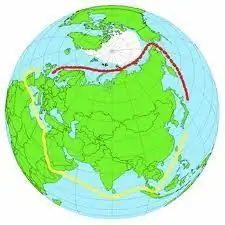2025 Author: Howard Calhoun | [email protected]. Last modified: 2025-01-24 13:10:36
A sea mine is a self-sufficient explosive device placed in the water to damage or destroy the hulls of ships, submarines, ferries, boats and other watercraft. Unlike depth charges, mines are in a “sleeping” position until they make contact with the side of the ship. Naval mines can be used both to inflict direct damage on the enemy and to impede his movements in strategic directions. In international law, the rules for mine warfare are established by the 8th Hague Convention of 1907.

Classification
Naval mines are classified according to the following criteria:
- Type of charge - conventional, special (nuclear).
- Degrees of selectivity - normal (for any purpose), selective (recognize the characteristics of the vessel).
- Controllability - controlled (by wire, acoustically, by radio), uncontrolled.
- Multiplicity - multiples (a given number of targets),non-multiple.
- Fuse type - non-contact (induction, hydrodynamic, acoustic, magnetic), contact (antenna, galvanic impact), combined.
- Installation type - homing (torpedo), pop-up, floating, bottom, anchor.
Mines usually have a round or oval shape (with the exception of torpedo mines), sizes from half a meter to 6 m (or more) in diameter. Anchors are characterized by a charge of up to 350 kg, bottom - up to a ton.
Historical background
Naval mines were first used by the Chinese in the 14th century. Their design was quite simple: there was a tarred barrel of gunpowder under the water, to which a wick led, supported on the surface by a float. To use it, it was necessary to set fire to the wick at the right time. The use of such structures is already found in treatises of the 16th century in the same China, but a more technologically advanced flint mechanism was used as a fuse. Advanced mines were used against Japanese pirates.
In Europe, the first naval mine was developed in 1574 by the Englishman Ralph Rabbards. A century later, the Dutchman Cornelius Drebbel, who served in the artillery department of England, proposed his own design of ineffective "floating firecrackers".

American designs
A truly formidable design was developed in the United States during the Revolutionary War by David Bushnell (1777). It was still the same powder keg, but equipped with a mechanism that detonated upon collision with the ship's hull.
At the height of the Civil War (1861) in the United States, Alfred Vaud invented a double-hull floating sea mine. The name for it was chosen appropriately - "infernal machine." The explosive was located in a metal cylinder, which was under water, which was held by a wooden barrel floating on the surface, which simultaneously served as a float and a detonator.
Domestic developments
For the first time, an electric fuse for "infernal machines" was invented by Russian engineer Pavel Schilling in 1812. During the unsuccessful siege of Kronstadt by the Anglo-French fleet (1854) in the Crimean War, a naval mine designed by Jacobi and Nobel proved to be excellent. One and a half thousand exposed "infernal machines" not only fettered the movement of the enemy fleet, but they also damaged three large British steamships.
Mina Jacobi-Nobel had its own buoyancy (thanks to the air chambers) and did not need floats. This made it possible to install it secretly, in the water column, hanging on chains, or let it go with the flow.
Later, a sphero-conical floating mine was actively used, held at the required depth by a small and inconspicuous buoy or anchor. It was first used in the Russian-Turkish war (1877-1878) and was in service with the fleet with subsequent improvements until the 1960s.

Anchor mine
She was kept at the required depth by the anchor end - a cable. The melting of the first samples was provided by manually adjusting the length of the cable, which required a lot of time. Lieutenant Azarov suggesteda design that allowed the automatic installation of naval mines.
The device was equipped with a system of lead weight and an anchor suspended above the weight. The anchor end was wound on a drum. Under the action of the load and anchor, the drum was released from the brake, and the end was unwound from the drum. When the load reached the bottom, the pulling force of the end decreased and the drum stopped, due to which the “hellish machine” plunged to a depth corresponding to the distance from the load to the anchor.

Early 20th century
Massively naval mines began to be used in the twentieth century. During the Boxer Rebellion in China (1899-1901), the imperial army mined the Haife River, blocking the way to Beijing. In the Russo-Japanese confrontation in 1905, the first mine war unfolded, when both sides actively used massive barrages and minefield breakthroughs with the help of minesweepers.
This experience was adopted in the First World War. German naval mines prevented the landing of the British troops and fettered the actions of the Russian fleet. Submarines mined trade routes, bays and straits. The Allies did not remain in debt, practically blocking the exits from the North Sea for Germany (this took 70,000 mines). The total number of "infernal machines" used by experts is estimated at 235,000 pieces.

World War II naval mines
During the war, about a million mines were delivered to the naval theaters of operations, including more than 160,000 in the waters of the USSR. Germany wasweapons of death were installed in the seas, lakes, rivers, in the ice-bound Kara Sea and in the lower reaches of the Ob River. Retreating, the enemy mined port moorings, raids, harbors. The mine war in the B altic was especially cruel, where the Germans delivered more than 70,000 mines in the Gulf of Finland alone.
As a result of mine explosions, approximately 8,000 ships and vessels sank. In addition, thousands of ships were heavily damaged. In European waters, already in the post-war period, 558 ships were blown up by sea mines, 290 of which sank. On the very first day of the start of the war in the B altic, the destroyer "Angry" and the cruiser "Maxim Gorky" were blown up.
German mines
German engineers at the beginning of the war surprised the allies with new highly effective types of mines with a magnetic fuse. The sea mine exploded not from contact. It was enough for the ship to sail close enough to the lethal charge. Its shock wave was enough to turn the side. Damaged ships had to abort the mission and return for repairs.
The English fleet suffered more than others. Churchill personally made it his highest priority to develop a similar design and find an effective means of clearing mines, but British specialists could not reveal the secret of the technology. The case helped. One of the mines dropped by the German plane got stuck in the coastal silt. It turned out that the explosive mechanism was quite complex and was based on the Earth's magnetic field. Research has helped create efficient minesweepers.

Soviet mines
Soviet naval mines were notso technologically advanced, but no less effective. The models of KB "Crab" and AG were mainly used. "Crab" was an anchor mine. KB-1 was put into service in 1931, in 1940 - the modernized KB-3. Intended for mass mine laying, in total, the fleet had about 8,000 units at the start of the war. With a length of 2 meters and a mass of over a ton, the device contained 230 kg of explosives.
Antenna deep-water mine (AG) was used to flood submarines and ships, as well as to impede the navigation of the enemy fleet. In fact, it was a modification of the design bureau with antenna devices. During combat setting in sea water, the electrical potential was equalized between two copper antennas. When the antenna touched the hull of a submarine or ship, the potential balance was disturbed, which caused the electrical circuit of the fuse to close. One mine "controlled" 60 m of space. General characteristics correspond to the KB model. Later, copper antennas (requiring 30 kg of valuable metal) were replaced with steel ones, the product received the designation AGSB. Few people know the name of the sea mine of the AGSB model: a deep-water antenna mine with steel antennas and equipment assembled into a single unit.
Mine clearance
70 years later, World War II sea mines still pose a threat to peaceful shipping. A large number of them still remain somewhere in the depths of the B altic. Until 1945, only 7% of the mines were cleared, the rest required decades of dangerous mine clearance work.
The main burden of the fight against the mine danger fell on the personnel of minesweepers inpost-war years. In the USSR alone, about 2,000 minesweepers and up to 100,000 personnel were involved. The degree of risk was exceptionally high due to constantly counteracting factors:
- unknown borders of minefields;
- different depths of setting mines;
- of various types of mines (anchor, antenna, with traps, bottom non-contact mines with urgency and multiplicity devices);
- possibility of being hit by fragments of exploding mines.
Trawl technology
The trawling method was far from perfect and dangerous. At the risk of being blown up by mines, the ships walked along the minefield and pulled the trawl behind them. Hence the constant stressful state of people from the expectation of a deadly explosion.
The mine cut by the trawl and the floating mine (if it did not explode under the ship or in the trawl) must be destroyed. When the sea is rough, fix a subversive cartridge on it. Undermining a mine is more reliable than shooting it from a ship's cannon, since the projectile often pierced the shell of the mine without hitting the fuse. An unexploded military mine lay on the ground, presenting a new, no longer amenable to liquidation danger.

Conclusion
Naval mine, the photo of which inspires fear only by its appearance, is still a formidable, deadly, and at the same time cheap weapon. Devices have become even smarter and more powerful. There are developments with an installed nuclear charge. In addition to the listed types, there are towed, pole, throwing, self-propelled and other "hellish machines".
Recommended:
Detailed photo studio business plan. How to open a photo studio?

A good photograph is comparable only to a brilliant printed work that has not changed its content over the centuries, but at the same time every family wants to have it
Northern Sea Route. Ports of the Northern Sea Route. Development, significance and development of the Northern Sea Route

In recent years, the Arctic is one of the key regions in terms of Russia's national interests. One of the most important aspects of Russia's presence here is the development of the Northern Sea Route
Obukhovskaya mine: description, output, photo

More than 100 years ago, the legend of Russian geologists, Obukhov, discovered near the Zverevo station an exit to the earth's surface of a powerful and unique coal seam - k2. And forty years ago, at the end of December 1978, the Obukhovskaya mine was built and put into operation on this site, recognized as the largest mine in Eastern Europe
Golovnaya Zaramagskaya HPP: height above sea level, photo, location, connection diagram

North Ossetia is rich in wild mountain rivers. These rivers have enormous potential in hydropower. In 2009, the head Zaramagskaya HPP was launched. The river on which the hydroelectric power station is located is called Ardon
Kirov mine: description, history, photo

Kirovsky mine is located in the Murmansk region, is the leading asset of JSC "Apatit". The enterprise develops a deposit of apatite-nepheline ores, enriches them and produces fertilizer concentrates. The company is a city-forming company for the cities of Apatity and Kirovsk, providing jobs for more than 13 thousand people

